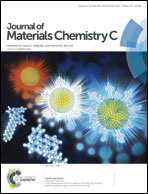An electrochemiluminescence amplification strategy: a synergistic effect of electrospun Ru(bpy)32+/CNT/ionic liquid composite nanofibers†
Abstract
Electrospun Ru(bpy)32+/carbon nanotube (CNT)/room temperature ionic liquid (IL: 1-butyl-3-methylimidazolium hexafluorophosphate (BMIMPF6)) composite polyacrylonitrile (PAN) nanofibers (CNT/IL/PAN) were successfully fabricated by a one-step electrospinning technique. Utilizing high binding capacity of both carboxylic acid functionalized multiwalled CNTs and large structure anion PF6− (derived from BMIMPF6) to Ru(bpy)32+, the composite nanofibers can serve as an excellent Ru(bpy)32+ immobilization nanomatrix for electrochemiluminescence (ECL) sensing. Using electrochemistry and fluorescence techniques, the composite nanofibers demonstrated superior electron transfer capability and ECL significant amplification. These results might be attributed to a synergistic effect between CNTs and ILs which both have unique electronic and catalytic properties. The ECL intensity from the composite nanofibers was 23.4-fold larger than that of PAN nanofibers, 1.7-fold greater than CNT/PAN nanofibers, and 2.4-fold greater than IL/PAN nanofibers. Furthermore, the composite nanofibers exhibited the largest ECL quenching efficiency, 8.2 times more than that of the PAN nanofibers in the presence of the same phenol concentration (20 μM). Moreover, a nanofiber-based ECL sensor has great selectivity, stability and reusability. In a word, an ECL sensor based on the CNT/IL/PAN nanofibers was developed to sensitively detect phenolic compounds with a low detection limit of 1.0 nM for phenols. A novel ECL amplification strategy based on the synergistic effect between doped CNTs and doped ILs within nanofibers was demonstrated and developed to a promising ECL sensing nanoplatform for ultrasensitive and fast detection.


 Please wait while we load your content...
Please wait while we load your content...